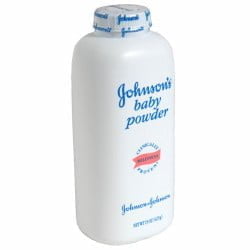
The awareness of talculm powder and the alleged link to ovarian cancer is spreading, but few consumers realize the strength of the science behind the two.
Among the science linking the two include 22 different studies.
Since as early as 1982, there have been approximately 22 epidemiologic studies providing data about a possible link between talculm powder and ovarian cancer. Most have reported an elevated risk for ovarian cancer. Nonetheless, the link is still relatively unknown by the public at large.
A Complaint recently filed in Chicago detailed the studies. Among the evidence includes:
- In 1983, a case-control study found a 150% increased risk of ovarian cancer for women who use talcum powder in the genital area. Hartge, P., et al. Talc and Ovarian Cancer. JAMA. 1983; 250(14): 1844.
- In 1988, a case-control study of 188 women diagnosed with epithelial ovarian cancer and 539 control women found that 52% of the cancer patients habitually
used talcum powder on the genital area before their cancer diagnosis. The study
showed a 50% increase in risk of ovarian cancer in women that used talcum powder
on their genital area and a positive dose-response relationship. Whittemore AS, et
al. Personal and environmental characteristics related to epithelial ovarian cancer.
II. Exposures to talcum powder, tobacco, alcohol, and coffee. Am. J. Epidemiol.
1988 Dec; 128(6):1228-40. - A 1989 study looked at 235 women diagnosed with epithelial ovarian cancer and
451 controls, and found a 29% increased risk in ovarian cancer with women who
reported genital talcum powder use more than once each week. Booth, M., et al.
Risk factors for ovarian cancer: a case-control study. Br J Cancer. 1989 Oct;
60(4):592-8. - In 1992, a case-control study found a statistically significant 80% increased risk of
ovarian cancer in women with more than 10,000 lifetime perineal applications of
talc, demonstrating a positive dose-response relationship. Harlow BL, et al.
Perineal exposure to talc and ovarian cancer risk. Obstet Gynecol. 1992 Jul;
80(1):19-26. - Another 1992 case-control study reported a 70% increased risk from genital talc
use and a 379% increased risk of ovarian cancer of women who used talc on
sanitary napkins in their genital area. Rosenblatt, K.A. et al. Mineral fiber exposure
and the development of ovarian cancer. Gynecol Oncol. 1992 Apr; 45(l):20-5. - In 1995, the largest study of its kind to date found a statistically significant 27%
increased risk in ovarian cancer for women who regularly use talc in the abdominal
or perineal area. Purdie, D., et al. Reproductive and other factors and risk of
epithelial ovarian cancer: An Australian case-control study. Survey of Women’s
Health Study Group. Int JCancer. 1995 Sep 15; 62(6):678-84. - In 1996, a case-control study found a statistically significant 97% increased risk of
ovarian cancer in women who used what they described as a “moderate” or higher
use of talc-based powders in their genital area. See Shushan, A., et al. Human
menopausal gonadotropin and the risk of epithelial ovarian cancer. Fertil. Steril.
1996 Jan; 65(l):13-8. - In 1997, a case-control study of 313 women with ovarian cancer and 422 without
this disease found that the women with cancer were more likely to have applied
talcum powder to their external genitalia area. Women using these products had a
statistically significant 50% to 90% higher risk of developing ovarian cancer. Cook,
LS, et al. Perineal powder exposure and the risk of ovarian cancer. Am. J Epidemiol.
1997 Mar 1; 145(5):459-65. - In 1997, a case-control study involving over 1,000 women found a statistically
significant increased risk of 42% for ovarian cancer for women who applied talc
via sanitary napkins to their perineal area. Chang, S, et al. Perineal talc exposure
and risk of ovarian carcinoma. Cancer. 1997 Jun 15; 79(12):2396-401. - In 1998, a case-control study found a 149% increased risk of ovarian cancer in
women who used talc-based powders on their perineal area. Godard, B., et al. Risk
factors for familial and sporadic ovarian cancer among French Canadians: a case-
control study. Am J Obstet Gynecol. 1998 Aug; 179(2):403-10. - Dr. Daniel Cramer conducted another case-control study in 1999, observing 563
women newly diagnosed with epithelial ovarian cancer and 523 women in a control.
The study found a statistically significant 60% increased risk of ovarian cancer in
women that used talc-based body powders on their perineal area and an 80%
increase in risk for women with over 10,000 lifetime applications. Cramer, DW, et
al. Genital talc exposure and risk of ovarian cancer. Int J Cancer. 1999 May 5;
81 (3):351-56. - In 2000, a case-control study of over 2,000 women found a statistically significant
50% increased risk of ovarian cancer from genital talc use in women. Ness, RB, et al. Factors related to inflammation of the ovarian epithelium and risk of ovariancancer. Epidemiology. 2000 Mar; 11 (2): 111 -7. - In 2004, a case-control study of nearly 1,400 women from 22 counties in Central
California found a statistically significant 37% increased risk of epithelial ovarian
cancer from women’s genital talc use, and a 77% increased risk of serous invasive
ovarian cancer from women’s genital talc use. Importantly, this study also
examined women’s use of cornstarch powders as an alternative to talc, and found
no increased risk in ovarian cancer in women in the cornstarch group, further
supporting the causal connection between genital talc use and ovarian cancer. Mills,
PK, et al. Perineal talc exposure and epithelial ovarian cancer risk in the Central
Valley of California. Int J Cancer. 2004 Nov 10; 112(3):458-64. - In 2008, a combined study of over 3,000 women from a New England-based case-
control study found a general 36% statistically significant increased risk of
epithelial ovarian cancer from genital talc use and a 60% increased risk of the serous
invasive ovarian cancer subtype. The study also found a strong dose response
relationship between the cumulative talc exposure and incidence of ovarian cancer,
adding further support to the causal relationship. Gates, MA, et al. Talc Use,
Variants of the GSTM1, GSTT1, and NAT2 Genes, and Risk of Epithelial Ovarian
Cancer. Cancer Epidemiol Biomarkers Prev. 2008 Sep; 17(9):2436-44. - A 2009 case-control study of over 1,200 women found the risk of ovarian cancer
increased significantly with increasing frequency and duration of talc use, with an
overall statistically significant 53% increased risk of ovarian cancer from genital
talc use. That increased risk rose dramatically, to 108%, in women with the longest
duration and most frequent talc use. Wu, AH, et al. Markers of inflammation and
risk of ovarian cancer in Los Angeles County. Int. J Cancer. 2009 Mar 15;
124(6):1409-15. - In 2011, another case-control study of over 2,000 women found a 27% increased
risk of ovarian cancer from genital talc use. Rosenblatt, KA, et al. Genital powder
exposure and the risk of epithelial ovarian cancer. Cancer Causes Control. 2011
May; 22(5):737-42. - In June of 2013, a pooled analysis of over 18,000 women in eight case-control
studies found a 20% to 30% increased risk of women developing epithelial ovarian
cancer from genital powder use. The study concluded by stating, “Because there
are few modifiable risk factors for ovarian cancer, avoidance of genital powders
may be a possible strategy to reduce ovarian cancer incidence.” Terry, KL, et al.
Genital powder use and risk of ovarian cancer: a pooled analysis of 8,525 cases and
9,859 controls. Cancer Prev Res (Phila). 2013 Aug; 6(8):811-21.
Other evidence cited by the complaint:
- In 1993, the United States National Toxicology Program published a study on the
toxicity of non-asbestiform talc and found clear evidence of carcinogenic activity. Talc was found to be a carcinogen, with or without the presence of asbestos-like fibers. - On November 10, 1994, the Cancer Prevention Coalition mailed a letter to then
Johnson & Johnson C.E.O, Ralph Larson, informing his company that studies as far back as 1960’s “. . . show[ ] conclusively that the frequent use of talcum powder in the genital area poses a serious health risk of ovarian cancer.” The letter cited a recent study by Dr. Bernard Harlow from Harvard Medical School confirming this fact and quoted a portion of the study where Dr. Harlow and his colleagues discouraged the use of talc in the female genital area. The letter further stated that 14,000 women per year die from ovarian cancer and that this type of cancer is very difficult to detect and has a low survival rate. The letter concluded by requesting that Johnson & Johnson withdraw talc products from the market because of the alternative of cornstarch powders, or at a minimum, place warning information on its talc-based body powders about ovarian cancer risk they pose. - In 1996, the condom industry stopped dusting condoms with talc due to the growing health concerns.
- In February of 2006, the International Association for the Research of Cancer (IARC) part of the World Health Organization published a paper whereby they classified perineal use of talc-based body powder as a “Group 2B” human carcinogen.
- In approximately 2006, the Canadian government under The Hazardous Products Act and associated Controlled Products Regulations classified talc as a “D2A,” “very toxic,”
“cancer causing” substance under its Workplace Hazardous Materials Information System (WHMIS). Asbestos is also classified as “D2A”. - In 2006, Imerys Talc began placing a warning on the Material Safety Data Sheets (MSDS) it provided to Defendants regarding the talc it sold to them to be used in the Products.
The lawsuits are fast piling up against Johnson & Johnson and thus far the company has endured enormous verdicts ($55M and $72M) with additional cases being teed up for trial in 2017.






